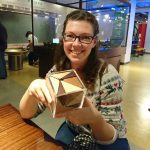This is the last match in our group stage: from Group 4, it’s Colin Beveridge up against Becky Warren. The pitches are below, and at the end of this post there’s a poll where you can vote for your favourite bit of maths.
Take a look at both pitches, vote for the bit of maths that made you do the loudest “Aha!”, and if you know any more cool facts about either of the topics presented here, please write a comment below!
Colin Beveridge – My favourite shape

Colin Beveridge is the author of two popular maths books and several unpopular ones, all of which are available wherever good books are sold. He writes the Flying Colours Maths blog, brings up two children with his partner, and has his eyes on a triathlon in the distant future. He has an equation named after him and once set himself on fire making a sandwich. He’s @icecolbeveridge on Twitter.
In today’s pitch, I tell you a bit about my favourite 3D shape.
Here’s the Geogebra animation, which cuts off a bit quickly in the video.
Here’s a net so you can make your own and see all the great circles.
Becky Warren – Summing consecutive numbers

Becky Warren is a freelance maths educator and communicator. She loves neat mathematical puzzles, mathematical art and origami. Her occasionally updated blog is called Lines Curves Spirals. She’s @becky_k_warren on Twitter, where she loves joining in the #beingmathematical chat on Thursdays.
I was quite far along in my mathematical journey when I found out that triangular numbers could be represented as a triangular arrangement of objects. (I think I had completed school, a maths degree and was on my way to becoming a maths teacher!) I hadn’t seen much maths shown visually and I found it very pleasing.
For those who aren’t familiar with the triangular numbers they are just the sum of the first $n$ numbers. We can write the $n^{\text{th}}$ triangular number as $T_n$, then we would have:
\begin{align}
T_1 &= 1 &= 1 \\
T_2 &= 1+2 &= 3 \\
T_3 &= 1+2+3 &= 6 \\
T_4 &= 1+2+3+4 &= 10 \\
\ldots \\
T_n &= 1+2+ \ldots + n
\end{align}
When finding the sum of the positive integers we might find it easier to rearrange the counters into a rectangular array.
Here we can see that the 7th triangular number can be found by calculating 4 multiplied by 7.
We can generalise this by noticing that the 4 is the middle number, which can be calculated by adding the first and last number and dividing by 2. Also, 7 is the width of our original triangle.
So in general we have $T_n = \frac{1}{2}(n+1) \times n$.
This holds even when n is even. The diagram for $T_6$ looks like this. We can see that we need to multiply 3½ by 6. There is no middle number here but we can see that if we add the first and last numbers and divide by 2 we still get the height.
What happens if we sum consecutive integers but we remove the constraint that we start at 1?
\begin{align}
2+3 &= 5 \\
3+4 &= 7 \\
3+4+5 &= 12
\end{align}
What numbers can we make?
Here are the possible numbers up to 15
\begin{align}
2 &= \text{not possible} \\
3 &= 1+2 \\
4 &= \text{not possible} \\
5 &= 2+3 \\
6 &= 1+2+3 \\
7 &= 3+4 \\
8 &= \text{not possible} \\
9 &= 4+5 = 2+3+4 \\
10 &= 1+2+3+4 \\
11 &= 5+6 \\
12 &= 3+4+5 \\
13 &= 6+7 \\
14 &= 2+3+4+5 \\
15 &= 7+8 = 4+5+6 = 1+2+3+4+5
\end{align}
It appears from these examples that we can’t make powers of 2. There is a neat little proof of this.
When we are adding an odd number of numbers we start with an arrangement of counters in a stepped formation with an odd number of columns. It is then possible to rearrange the counters into a rectangular array that has the same width. Therefore we can see that the total will have to have an odd factor.
The even case is trickier. However, if we note that the height of the rectangular array we can create is the average of the two middle numbers we can write the sum as
\begin{align}
\text{Sum} &= (\text{sum of middle two numbers}) \times \frac{1}{2} \times (\text{number of columns}) \\
&= (\text{odd number}) \times \frac{1}{2} \times (\text{even number}) \\
&= (\text{odd number}) \times (\text{whole number})
\end{align}
This shows that every sum of consecutive numbers has an odd factor and therefore can’t be a power of 2. Nice!
Another nice result that I didn’t know about for a long time is that the summing all of the odd integers from $1$ to $2n – 1$ makes the $n^{\text{th}}$ square number.
I wonder what numbers can be made from summing consecutive odd numbers?
So, which bit of maths do you want to win? Vote now!
Match 24: Group 4 - Colin Beveridge vs Becky Warren
- Becky with number sums
- (71%, 96 Votes)
- Colin with the icosidodecahedron
- (29%, 39 Votes)
Total Voters: 135
This poll is closed.
The poll closes at 9am BST on the 25th. Whoever wins the most votes will win the match, and once the group stages are over, the number of wins will determine who goes through to the semi-final.
Come back in two days’ time for the first semi-final, featuring the winners of groups 1 and 2. Or check out the announcement post for your follow-along wall chart!
Is it possible to embed the animations on such a way that they can be paused? (Or am I missing a way of doing this on my MacBook?)